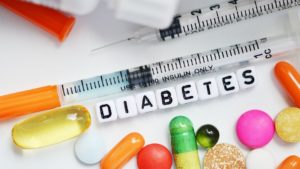Hyperbaric Oxygen Therapy for Diabetes Support and Treatment
30.3 million Americans, or 9.4% of the population, has diabetes (as of 2015). 1.5 million Americans are diagnosed with diabetes every year. Diabetes remains the 7th leading cause of death in the United States (as of 2015), with 79,535 death certificates listing it as the underlying cause of death, and a total of 252,806 death certificates listing diabetes as an underlying or contributing cause of death.
Source: American Diabetes Association

With diabetes primarily affecting the small blood vessels, hyperbaric oxygen therapy (HBOT) has been demonstrated to stimulate angiogenesis to help ameliorate compromised blood flow and prevent organ failure. Research has shown that HBOT can lower blood sugar levels by increasing cellular sensitivity to insulin and skeletal muscle reception of glucose. Furthermore, recent reports have provided evidence towards linking HBOT to regenerating pancreatic islets of Langerhans, thus potentially producing more insulin. HBOT is often beneficial in treating osteomyelitis and cellulitis, in addition to preventing systemic toxicity and permanent disability. With chronic diabetes, impaired circulation reduces wound healing capability and promotes ulcerations. HBOT increases the amount of oxygen available to ulcerated areas, leading to increased fibroblast activation.
Benefits of Hyperbaric Oxygen Therapy as a Diabetes Treatment
Studies have demonstrated the following benefits of hyperbaric oxygen therapy for diabetes.
Improve Blood Chemistry Profile with HBOT
- Fasting Blood Sugar
- Hemoglobin HbA1C
- Lipid Profiles
Advance Glycemic Control with HBOT
- Increases Pancreatic Islets of Langerhans
- Improves Insulin Sensitivity
- Increases Skeletal Muscle Reception of Glucose
Decrease Cardiovascular Risk with HBOT
- Promotes Long-Term Blood Pressure Control
- Attenuates Metabolic Syndrome
- Reduces Risk of Sudden Heart Attack Due to Ventricular Arrhythmias
Stimulate Angiogenesis and Reduce Inflammation with HBOT
- Improves Brain Function and Reduces Risk of Stroke
- Enhances Heart Function and Reduces Risk of Heart Attack
- Reduces Risk of Diabetic Retinopathy
- Decreases Risk of Diabetic Neuropathy
- Minimizes Risk of Diabetic Nephropathy
- Combats Cellulitis
Enhance Internal/External Healing with HBOT
- Proliferates Epithelialization
- Promotes Closure of Non-Healing Wounds
- Decreases Risk of Infection
- Ameliorates Ulcerations
- Reduces Risk of Amputation
- Remediates Osteomyelitis
Source: International Hyperbarics Association
Information on this website is provided for educational purposes only. It is not intended as a substitute for the diagnosis, treatment, and advice of a qualified licensed professional. This website offers general information and in no way should anyone consider that this website represents the practice of medicine. This website assumes no responsibility for how this information is used. Also note that this website frequently updates its contents, due to a variety of reasons. No statements or implied treatments on this website have been evaluated or approved by the FDA. It is important that you do not reduce, change, or discontinue any medication or treatment without first consulting your doctor. Please consult your doctor before beginning any new program of treatment.
Study: Low-Pressure HBOT Shown to be Effective in Metabolic Syndrome Treatment and Reducing Cardiac Risks
A study published in the Journal of Atherosclerosis and Thrombosis (2017 Jan 1) shows that low-pressure hyperbaric oxygen therapy can be a very effective tool for helping those suffering from metabolic syndrome. Metabolic syndrome is a cluster of conditions, including increased blood pressure, high blood sugar, excess body fat around the waist, and abnormal cholesterol or triglyceride levels. The syndrome increases your risk of heart disease, stroke, and diabetes. This study looked at only 1.25 ATA (low-pressure hyperbarics) and found that this dosage was effective enough to produce a lowering of blood sugars, blood pressure, total cholesterol, and insulin. This treatment could be in any of the OxyLife Hyperbarics chambers, which go up to 1.3 ATA.
Study: Amputation Rate Decreased with HBOT
A study published in 2008 evaluated the efficacy of HBOT with respect to decreasing amputation rates for patients with a diabetic foot ulcer. A total of 184 consecutive patients received an average of 39 HBOT sessions (60 to 120 minutes a day, six times a week with patients’ progress evaluated at 3, 6 & 12 months) as an adjunct to standard treatment modalities for a diabetic foot ulcer. Following treatment, 115 (62 percent) were completely healed, 31 (17 percent) showed no improvement and 38 (21 percent) underwent amputation. HBOT’s success was illustrated by the attenuation to hypoxic tissue by the mechanisms of angiogenesis, fibroblast replication, collagen synthesis, revascularization, epithelialization and increased leukocyte bactericidal activity. This study confirmed that HBOT can help to reduce major amputation rates in diabetic foot ulcers by repairing tissue. This finding is especially noteworthy considering other conventional treatments had failed.
Study: mHBOT for Diabetes
Recent research, published in the Journal of Diabetes (April 2018), confirms some of the reported benefits of mild hyperbaric oxygen therapy (m-HBOT) for people with diabetes. The results indicate m-HBOT can provide significant benefits for people with diabetes. Results indicated lowered fasting and non-fasting glucose, HbA1c, and triglyceride levels.

